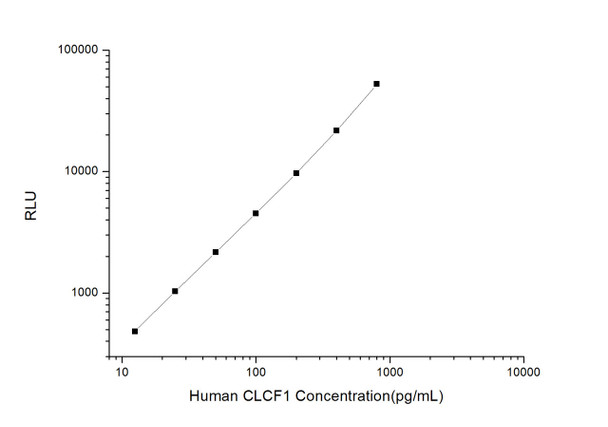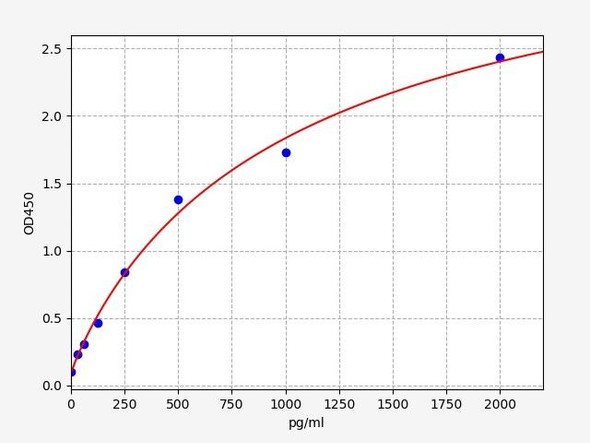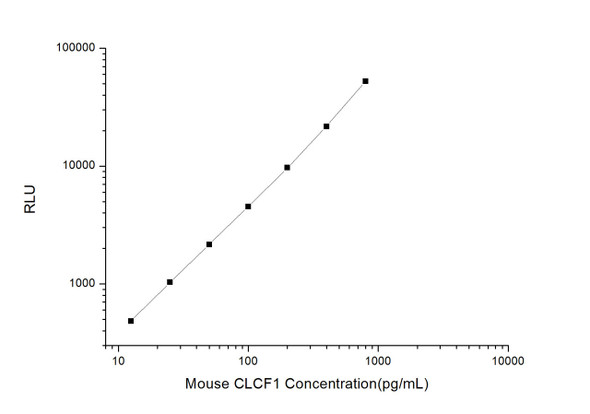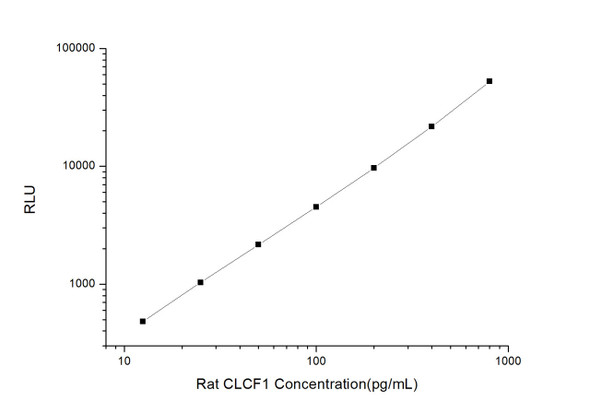Human Immunology ELISA Kits 11
Human CLCF1 (Cardiotrophin Like Cytokine Factor 1) CLIA Kit (HUES00431)
- SKU:
- HUES00431
- Product Type:
- ELISA Kit
- ELISA Type:
- CLIA Kit
- Size:
- 96 Assays
- Sensitivity:
- 7.5pg/mL
- Range:
- 12.5-800pg/mL
- ELISA Type:
- Sandwich
- Reactivity:
- Human
- Sample Type:
- Serum, plasma and other biological fluids
Description
| Assay type: | Sandwich |
| Format: | 96T |
| Assay time: | 4.5h |
| Reactivity: | Human |
| Detection method: | Chemiluminescence |
| Detection range: | 12.50-800 pg/mL |
| Sensitivity: | 7.50 pg/mL |
| Sample volume: | 100µL |
| Sample type: | Serum, plasma and other biological fluids |
| Repeatability: | CV < 15% |
| Specificity: | This kit recognizes Human CLCF1 in samples. No significant cross-reactivity or interference between Human CLCF1 and analogues was observed. |
This kit uses Sandwich-CLIA as the method. The micro CLIA plate provided in this kit has been pre-coated with an antibody specific to Human CLCF1. Standards or samples are added to the appropriate micro CLIA plate wells and combined with the specific antibody. Then a biotinylated detection antibody specific for Human CLCF1 and Avidin-Horseradish Peroxidase (HRP) conjugate are added to each micro plate well successively and incubated. Free components are washed away. The substrate solution is added to each well. Only those wells that contain Human CLCF1, biotinylated detection antibody and Avidin-HRP conjugate will appear fluorescence. The Relative light unit (RLU) value is measured spectrophotometrically by the Chemiluminescence immunoassay analyzer. The RLU value is positively associated with the concentration of Human CLCF1. The concentration of Human CLCF1 in the samples can be calculated by comparing the RLU of the samples to the standard curve.
| UniProt Protein Function: | CLCF1: Cytokine with B-cell stimulating capability. Binds to and activates the ILST/gp130 receptor. Defects in CLCF1 are the cause of cold-induced sweating syndrome type 2 (CISS2). Cold-induced sweating syndrome (CISS) is an autosomal recessive disorder characterized by profuse sweating induced by cool surroundings (temperatures of 7 to 18 degrees Celsius). Additional abnormalities include a high- arched palate, nasal voice, depressed nasal bridge, inability to fully extend the elbows and kyphoscoliosis. Belongs to the IL-6 superfamily. 2 isoforms of the human protein are produced by alternative splicing. |
| UniProt Protein Details: | Protein type:Apoptosis; Cytokine; Secreted, signal peptide; Secreted Chromosomal Location of Human Ortholog: 11q13. 3 Cellular Component: extracellular region Molecular Function:ciliary neurotrophic factor receptor binding; cytokine activity; growth factor activity; protein binding; protein heterodimerization activity; receptor binding Biological Process: B cell differentiation; cell surface receptor linked signal transduction; JAK-STAT cascade; negative regulation of neuron apoptosis; positive regulation of astrocyte differentiation; positive regulation of B cell proliferation; positive regulation of cell proliferation; positive regulation of immunoglobulin production; positive regulation of isotype switching to IgE isotypes; positive regulation of tyrosine phosphorylation of Stat3 protein Disease: Cold-induced Sweating Syndrome 2 |
| NCBI Summary: | This gene is a member of the glycoprotein (gp)130 cytokine family and encodes cardiotrophin-like cytokine factor 1 (CLCF1). CLCF1 forms a heterodimer complex with cytokine receptor-like factor 1 (CRLF1). This dimer competes with ciliary neurotrophic factor (CNTF) for binding to the ciliary neurotrophic factor receptor (CNTFR) complex, and activates the Jak-STAT signaling cascade. CLCF1 can be actively secreted from cells by forming a complex with soluble type I CRLF1 or soluble CNTFR. CLCF1 is a potent neurotrophic factor, B-cell stimulatory agent and neuroendocrine modulator of pituitary corticotroph function. Defects in CLCF1 cause cold-induced sweating syndrome 2 (CISS2). This syndrome is characterized by a profuse sweating after exposure to cold as well as congenital physical abnormalities of the head and spine. Alternative splicing results in multiple transcript variants encoding distinct isoforms. [provided by RefSeq, Oct 2009] |
| UniProt Code: | Q9UBD9 |
| NCBI GenInfo Identifier: | 56404673 |
| NCBI Gene ID: | 23529 |
| NCBI Accession: | Q9UBD9. 1 |
| UniProt Secondary Accession: | Q9UBD9,Q6NZA4, B4DNT4, |
| UniProt Related Accession: | Q9UBD9 |
| Molecular Weight: | 24,087 Da |
| NCBI Full Name: | Cardiotrophin-like cytokine factor 1 |
| NCBI Synonym Full Names: | cardiotrophin-like cytokine factor 1 |
| NCBI Official Symbol: | CLCF1 |
| NCBI Official Synonym Symbols: | CLC; NR6; BSF3; NNT1; BSF-3; CISS2; NNT-1 |
| NCBI Protein Information: | cardiotrophin-like cytokine factor 1 |
| UniProt Protein Name: | Cardiotrophin-like cytokine factor 1 |
| UniProt Synonym Protein Names: | B-cell-stimulating factor 3; BSF-3; Novel neurotrophin-1; NNT-1 |
| Protein Family: | Cardiotrophin-like cytokine factor |
| UniProt Gene Name: | CLCF1 |
| UniProt Entry Name: | CLCF1_HUMAN |
As the RLU values of the standard curve may vary according to the conditions of the actual assay performance (e. g. operator, pipetting technique, washing technique or temperature effects), the operator should establish a standard curve for each test. Typical standard curve and data is provided below for reference only.
| Concentration (pg/mL) | RLU | Average | Corrected |
| 800 | 48398 56886 | 52642 | 52616 |
| 400 | 20691 22777 | 21734 | 21708 |
| 200 | 10447 8969 | 9708 | 9682 |
| 100 | 4298 4806 | 4552 | 4526 |
| 50 | 2344 2032 | 2188 | 2162 |
| 25 | 1135 985 | 1060 | 1034 |
| 12.50 | 494 524 | 509 | 483 |
| 0 | 26 26 | 26 | -- |
Precision
Intra-assay Precision (Precision within an assay): 3 samples with low, mid range and high level Human CLCF1 were tested 20 times on one plate, respectively.
Inter-assay Precision (Precision between assays): 3 samples with low, mid range and high level Human CLCF1 were tested on 3 different plates, 20 replicates in each plate.
| Intra-assay Precision | Inter-assay Precision | |||||
| Sample | 1 | 2 | 3 | 1 | 2 | 3 |
| n | 20 | 20 | 20 | 20 | 20 | 20 |
| Mean (pg/mL) | 39.47 | 92.73 | 303.04 | 37.21 | 100.65 | 324.43 |
| Standard deviation | 3.88 | 8.65 | 22.97 | 3.36 | 8.83 | 21.54 |
| C V (%) | 9.83 | 9.33 | 7.58 | 9.03 | 8.77 | 6.64 |
Recovery
The recovery of Human CLCF1 spiked at three different levels in samples throughout the range of the assay was evaluated in various matrices.
| Sample Type | Range (%) | Average Recovery (%) |
| Serum (n=5) | 87-101 | 93 |
| EDTA plasma (n=5) | 94-110 | 102 |
| Cell culture media (n=5) | 92-108 | 100 |
Linearity
Samples were spiked with high concentrations of Human CLCF1 and diluted with Reference Standard & Sample Diluent to produce samples with values within the range of the assay.
| Serum (n=5) | EDTA plasma (n=5) | Cell culture media (n=5) | ||
| 1:2 | Range (%) | 92-106 | 92-107 | 96-112 |
| Average (%) | 99 | 98 | 103 | |
| 1:4 | Range (%) | 91-104 | 103-118 | 100-118 |
| Average (%) | 98 | 109 | 108 | |
| 1:8 | Range (%) | 84-96 | 94-106 | 95-110 |
| Average (%) | 91 | 100 | 103 | |
| 1:16 | Range (%) | 91-104 | 86-98 | 87-100 |
| Average (%) | 97 | 92 | 92 |
An unopened kit can be stored at 4°C for 1 month. If the kit is not used within 1 month, store the items separately according to the following conditions once the kit is received.
| Item | Specifications | Storage |
| Micro CLIA Plate(Dismountable) | 8 wells ×12 strips | -20°C, 6 months |
| Reference Standard | 2 vials | |
| Concentrated Biotinylated Detection Ab (100×) | 1 vial, 120 µL | |
| Concentrated HRP Conjugate (100×) | 1 vial, 120 µL | -20°C(shading light), 6 months |
| Reference Standard & Sample Diluent | 1 vial, 20 mL | 4°C, 6 months |
| Biotinylated Detection Ab Diluent | 1 vial, 14 mL | |
| HRP Conjugate Diluent | 1 vial, 14 mL | |
| Concentrated Wash Buffer (25×) | 1 vial, 30 mL | |
| Substrate Reagent A | 1 vial, 5 mL | 4°C (shading light) |
| Substrate Reagent B | 1 vial, 5 mL | 4°C (shading light) |
| Plate Sealer | 5 pieces | |
| Product Description | 1 copy | |
| Certificate of Analysis | 1 copy |
- Set standard, test sample and control (zero) wells on the pre-coated plate and record theirpositions. It is recommended to measure each standard and sample in duplicate. Note: addall solutions to the bottom of the plate wells while avoiding contact with the well walls. Ensuresolutions do not foam when adding to the wells.
- Aliquot 100µl of standard solutions into the standard wells.
- Add 100µl of Sample / Standard dilution buffer into the control (zero) well.
- Add 100µl of properly diluted sample (serum, plasma, tissue homogenates and otherbiological fluids. ) into test sample wells.
- Cover the plate with the sealer provided in the kit and incubate for 90 min at 37°C.
- Aspirate the liquid from each well, do not wash. Immediately add 100µL of BiotinylatedDetection Ab working solution to each well. Cover the plate with a plate seal and gently mix. Incubate for 1 hour at 37°C.
- Aspirate or decant the solution from the plate and add 350µL of wash buffer to each welland incubate for 1-2 minutes at room temperature. Aspirate the solution from each well andclap the plate on absorbent filter paper to dry. Repeat this process 3 times. Note: a microplatewasher can be used in this step and other wash steps.
- Add 100µL of HRP Conjugate working solution to each well. Cover with a plate seal andincubate for 30 min at 37°C.
- Aspirate or decant the solution from each well. Repeat the wash process for five times asconducted in step 7.
- Add 100µL of Substrate mixture solution to each well. Cover with a new plate seal andincubate for no more than 5 min at 37°C. Protect the plate from light.
- Determine the RLU value of each well immediately.






